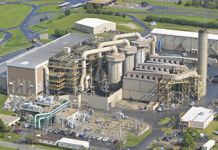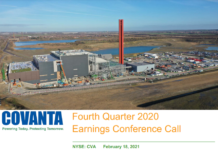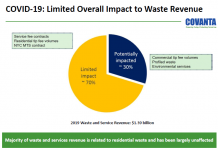Jim Lane
The first zero-cost feedstock biofuels company comes to the public markets with its IPO.
Like to see how this “Back the the Futuresque” technology unlocks value by converting household garbage into transportation fuel?
Here’s our 10-minute version of the IPO from Fulcrum Bioenergy.
In California, Fulcrum Bioenergy has filed an S-1 registration statement for a proposed $115 million initial public offering. The number of shares to be offered and the price range for the offering have not yet been determined. The company proposes to list under the symbol FLCM. UBS Investment Bank is the underwriter for the offering.
The company is currently ranked #45 in the world in the 50 Hottest Companies in Bioenergy. The rankings recognize innovation and achievement in fuels and are based on votes from a panel of invited international selectors, and votes from Digest subscribers.
Fulcrum becomes the 12th company to file for an IPO in the industrial biotech boom, which began with a successful listing on the NASDAQ by Codexis (CDXS) in 2010. IPOs by Amyris (AMRS), Gevo (GEVO), Solazyme (SZYM), and KiOR (KIOR) have followed. In recent months, PetroAlgae (PALG.OB), Myriant, Ceres, Genomatica, Mascoma and Elevance have also filed S-1 registrations for proposed IPOs.. Three in the past week, in fact.
Here’s the S-1 registration, in a conveniently downsized 10-minute Digest version – with some commentary along the way as to what is driving value in the Fulcrum model, opportunities for the intrepid investor, and some risks which we have translated from the ancient and original SEC into modern English.
Company Overview
Fulcrum produces advanced biofuel from garbage. Its business model combines a proprietary process and zero-cost municipal solid waste, or MSW, feedstock to provide them with what they term “a significant competitive advantage over companies using alternative feedstocks such as corn, sugarcane and other sources of biomass in the production of renewable fuel”. According to the filing, they have entered into long-term, zero-cost contracts for enough MSW located throughout the United States to produce more than 700 million gallons of ethanol per year; the core element of their technology, they confirm, has been demonstrated at full scale.
They intend to use a substantial portion of the IPO proceeds of this offering to fund the construction of its first commercial-scale ethanol production facility, the Sierra BioFuels Plant. At this facility, they expect to produce approximately 10 million gallons of ethanol per year at an unsubsidized cash operating cost of less than $1.30 per gallon, net of the sale of co-products such as renewable energy credits.
For a company that believes in waste, they sure don’t believe in large overhead. It’s a poster child for lean management in the development of advanced bioenergy. Employee headcount is just 17, at IPO time, with just 2 in research and development.
Development costs to date: net losses of $12.4 million, $16.5 million, and $18.0 million for 2008, 2009 and 2010, respectively and $13.8 million for the six months ended June 30, 2011. Total: $63.8 million.
The Technology
From the S-1: “In collaboration with a leading global engineering, consulting and construction company, we conducted an extensive review of more than 100 technologies and processes for producing large volumes of advanced biofuel and concluded that thermochemical technologies offered the most commercially viable solution. Based on this review, we developed a two-step process that consists of gasification followed by alcohol synthesis to produce ethanol from MSW. For the gasification step, we worked with InEnTec LLC, or InEnTec, to combine two gasification technologies into a single energy-efficient process to produce syngas from MSW. For the second step, we worked with Saskatchewan Research Council, or SRC, and Nipawin Biomass Ethanol New Generation Co-operative Ltd., or Nipawin, to integrate their thermochemical catalyst into our proprietary alcohol synthesis process to convert syngas to ethanol.”
The Market
The market-limiting factor for this biofuels process is not the overall demand for transport fuel, or ethanol, but the availability of MSW as a feedstock and the availability of sufficient tipping fees to ensure that arrival of zero-cost or negative-cost feedstock at the manufacturing facility gate.
From the S-1: “According to the EPA, annual MSW generation in the United States has trended upwards over the past several decades, increasing from 88 million tons in 1960 to 243 million tons in 2009. On average, each person in the United States generates approximately one ton of MSW per year. More than 85% of the MSW generated in 2009 was comprised of carbon- and hydrogen-based organic materials with latent energy content.
Waste collectors are charged fees for landfill waste disposal, which are referred to as tipping fees. According to the Waste Business Journal, the national average for tipping fees increased from $28.52 per ton in 1991 to $45.62 per ton in 2011, with considerably higher tipping fees in more densely populated regions.”
Based on the Fulcrum yields of 50 gallons per ton of MSW, the addressable US market is 12.15 billion gallons of ethanol.
The Strategy
Commence production at Sierra. They plan to commence construction of the first commercial-scale ethanol production facility by the end of 2011, with ethanol production expected to begin in the second half of 2013, at a total capacity of 10 million gallons per year.
Expand production capacity. They will use the the modular design of the technology to construct new, larger facilities quickly and efficiently, with future production capacity at 30- and 60-million gallons per year at future facilities. Such larger facilities would also lower both the capital cost per gallon and the fixed cost component of per gallon production costs (to as low as $0.90 per gallon), enhancing the economics.
Execute fixed-price offtake and hedging contracts. For each facility, we intend to enter into physical and/or financial fixed-price arrangements to lock in sufficient economics to cover a substantial portion of our fixed costs, including debt service.
Secure additional MSW contracts. Longer term, they intend to expand our business by entering into additional MSW feedstock agreements to increase the amount of resources we have available to supply our commercial facilities.
Explore new market opportunities. They may license the technology to third parties and/or partner with large strategic players, such as major oil and chemical companies, outside of the base model to build, own, and operate facilities within the United States.
The Commercialization Plan
Coming online in 2013 and located in the Tahoe-Reno Industrial Center approximately 20 miles east of Reno, Nevada, the cost of constructing the 10 million gallon Sierra project is estimated at $180 million, which will be financed through existing equity capital and proceeds from this IPO.
The State of Nevada currently has a demand for ethanol of more than 50
million gallons per year. Today, there are no ethanol producers in the state of Nevada, nor to our knowledge are there any slated for development other than Sierra. The State of California currently has a demand for more than 950 million gallons of ethanol per year and imports 80% of its total ethanol supply .
Future locations will have capacities of 30 or 60 million gallons, and unsubsidized cash operating costs of less than $0.90 per gallon.
They have identified more than 20 potential site locations across the United States for future development, located in the 19 states in which they have contractually secured zero-cost MSW. They believe opportunities may exist to co-locate our facilities at sites with significant infrastructure in place, such as refineries, which could lower our per-gallon capital costs.
Fulcrum as it sees itself: 11 Competitive Strengths
Zero cost feedstock. We have executed feedstock contracts with some of the largest waste service companies in the United States that will supply us with sufficient feedstock, at zero cost, to produce more than 700 million gallons of advanced biofuel annually for up to 20 years. Our use of MSW at zero cost removes the largest, and most volatile, component of traditional renewable fuels production cost from our cost structure. We believe this provides us with a significant cost advantage over competitors paying for feedstock or utilizing purpose-grown feedstocks.
Transportation advantage. Significant volumes of MSW are generated near metropolitan areas, providing us with a transportation advantage compared to feedstocks harvested or grown in rural areas that must ultimately transport either the feedstock or the fuel to metropolitan areas.
Reliable supply. The United States generates more than 243 million tons of MSW annually, the majority of which is rich in organic carbon, providing sufficient feedstock for our process to produce approximately 12 billion gallons of biofuel annually.
Established infrastructure. By using MSW, we benefit from existing infrastructure for collection, hauling and handling. No new logistical networks would be required to transport the feedstock to our facilities.
No competing use. We produce advanced biofuel from a true waste product that has no competing use, is not sought after by food producers and has no impact on food prices.
Clear path to commercialization. Our first commercial-scale ethanol production facility is expected to begin production in the second half of 2013. We expect to construct additional commercial-scale production facilities across the United States that will be supplied with MSW under our existing contractual arrangements with Waste Connections, Inc. Our modular plant design not only significantly reduces scale-up risk, but will also allow us to construct new facilities and deploy our capital efficiently to capture a meaningful share of the ethanol market in the United States.
Proprietary process not dependent on yield improvement. Our process integrates a catalyst that converts syngas into ethanol, and we have demonstrated the success of this process at full scale at our demonstration facility. We believe our process will produce ethanol at net yields of approximately 70 gallons per ton of MSW, which we believe is sufficient for us to operate profitably in the absence of economic subsidies.
Business model built for long-term and sustainable profitability. We do not rely on government subsidies to make our product commercially viable. While we benefit from policies such as RFS2 and the LCFS, and will access incentives available for the production of our advanced biofuel, we expect our product to be sold on a cost-competitive basis with existing transportation fuels without any reliance on subsidies.
Flexible production process. We have designed our proprietary alcohol synthesis process to give us the flexibility to produce alcohols other than ethanol and take advantage of opportunities in other renewable fuels and chemical markets.
Benefits for our customers. Zero-cost feedstock; stable cost structure. Access to domestically-produced advanced biofuel. Large-scale development program.
Benefits for our MSW suppliers. A cheaper source of waste diversion than traditional landfill disposal. Extend landfill life at existing capacity levels. Avoidance of methane gas emissions.
The Risks, Translated from SEC-speak
In SEC speak: We are a development stage company with a limited operating history, and we have not yet generated any revenue. We currently expect to begin constructing our first commercial ethanol production facility, the Sierra BioFuels Plant, or Sierra, by the end of 2011, and to begin production in the second half of 2013.
In English: We ain’t sold nuttin’, honey. Cause we ain’t built it yet.
In SEC speak: To date, the components of our process have been demonstrated or used separately, but we have not previously demonstrated the processes on a fully-integrated basis at a single location or on a commercial scale.
In English: “Salagadoola mechicka boola bibbidi-bobbidi-boo. Put ‘em together and what have you got? Bibbidi-bobbidi-boo.”
In SEC speak: We are currently in the process of negotiating a term sheet with the U.S. Department of Energy, or DOE, for a loan guarantee to fund a portion of the construction costs associated with Sierra. As a part of the loan guarantee process, the DOE and its independent consultants conduct due diligence on projects which includes a rigorous investigation and analysis of the technical, financial, contractual, market and legal strengths and weaknesses of each project.
In English: S-O-L-Y-N-D-R-A.
In SEC speak: In order to produce sufficient yields of ethanol to make our facilities economically viable, we will require large volumes of MSW feedstock. Though we have entered into long-term MSW feedstock supply agreements with waste companies to provide enough feedstock to produce more than 700 million gallons of ethanol annually at zero cost, deliveries by such companies may be disrupted due to weather, transportation or labor issues or other reasons outside of our control.
In English: “Keep America Beautiful” – throw lots and lots of litter in the general direction of Lake Tahoe, please.
In SEC speak: We will also apply to the State of California to have our ethanol certified under California’s Low Carbon Fuel Standard, or LCFS, which would make our ethanol eligible for the carbon intensity reduction credits that will be available under this program for reducing the carbon intensity of California’s transportation fuels.
In English: Not that California might actually pull the rug out from underneath any biofuels venture. Nah, never happen.
In SEC speak: As of June 30, 2011, our executive officers, directors and beneficial holders of 5% or more of our outstanding stock owned almost all of our outstanding voting stock. As a result, these stockholders, acting together, would be able to significantly influence all matters requiring approval by our stockholders, including the election of directors and the approval of mergers or other business combination transactions.
In English: Ah, Skywalker, you will not be a full member of the Jedi Council at this time.
Financing to date
In 2007, James A. C. McDermott, the Managing Partner of USRG Management Company had contributed or made commitments to contribute $1.0 million to the LLC, for 6,741,573 shares of Series A convertible preferred stock.
In August 2007 and February 20
08, they sold an aggregate of 14,000,000 shares of our Series B convertible preferred stock at $1.00 per share for an aggregate purchase price of $14.0 million.
In October 2008, they issued two Senior Secured Convertible Notes, to USRG Holdco III and Rustic Canyon Ventures III, with an initial maximum principal amount of $5.0 million for a maximum aggregate principal amount of $10.0 million, which accrued interest at the rate of 8% per year
In March 2010, they issued two new Senior Secured Convertible Notes to the same parties – the 2010 USRG Note and the 2010 Rustic Canyon Note, with an initial aggregate principal amount of $4.0 million.
In June 2010, the 2008 USRG Note and the 2008 Rustic Canyon Note were converted into 13,450,762 shares of Series B-2 preferred stock, in exchange for the conversion of $26.9 million in principal amounts and accrued interest owed on the notes.
In September 2011, the 2010 USRG Note and the 2010 Rustic Canyon Note were converted into 12,924,605 shares of Series C-1 preferred stock at $2.67 per share, in exchange for the conversion of $32.5 million aggregate principal amount of our senior secured convertible notes and $2.0 million of accrued interest.
Also in September 2011, they sold, or expect to sell prior to completion of this offering, an aggregate of 29,216,738 shares of our Series C-1 convertible preferred stock at $2.67 per share for an aggregate purchase price of $78.0 million, including the conversion of the 2010 USRG Note and the 2010 Rustic Canyon Note.
Fair Valuation by the board of directors
November 1, 2007: $0.24
April 19, 2010: $0.41
June 27, 2011: $1.53
The bottom line
This is the first of the waste-to-biofuels companies to come to the public markets, which elevates the opportunity and risk for the investor in the absence of a benchmark IPO offering.
The company has spent $63.8M to date bringing itself to the cusp of commercialization, which is relatively cheap as advanced biofuels goes. Several companies have filed IPOs after racking up more than $100M in development costs to the point of constructing their first commercial facility.
Like most others (but not all) in this IPO wave, Fulcrum comes to the market with no revenues, and as a financing event rather than a liquidity event for existing shareholders. Having had most of 2011to raise capital, they have (after completing their 2011 pre-IPO financing) $49M in the bank as of June 30th.
Attractive aspects of this filing: zero-cost, locked in feedstock. Assuming we believe the cost estimates from the demonstration-level work that has proceeded to date, there’s not much that can go materially wrong in terms of the proposed production cost of $1.30 per gallon for ethanol.
Unattractive aspects: aside from the absence of a full-scale demonstration, there’s a high capital cost for this process (at the Sierra facility) of $18 per gallon of capacity – that’s more than nine times the cost of building out corn ethanol at scale – though corn ethanol producers (buying on the spot market) are looking at feds rock costs in the $2.50 per gallon range. Even assuming zero-debt and a 20-year life for the facility, the amortized capital cost of this facility will raise the overall fixed production cost to $2.20 per gallon on an unsubsidized basis, which leaves little room for profit at current spot ethanol prices of $2.50 per gallon and exposed at the CBOT current October 2012 ethanol futures price of $2.12 per gallon.
On the other hand, with its 75 percent GHG reduction, Fulcrum will not be competing head-to-head against, say, corn ethanol, but rather be competing within the cellulosic biofuels pool, which in the RFS is restricted to technologies that produce a 60 percent or higher GHG savings. There, the prices (given tight supply for some time to come) are expected to be higher.
Pools of risk: Aside from the aforementioned risks associated with the Sierra project, we have a sketchy, but not contracted out, pathway to future facilities.
The complete S-1 registration statement is here.
Jim Lane is the Editor and Publisher of Biofuels Digest.








